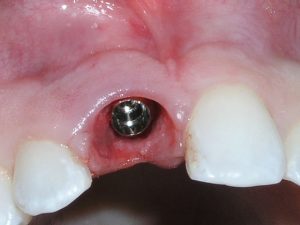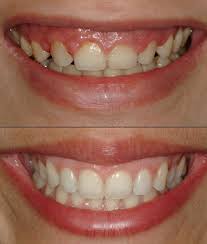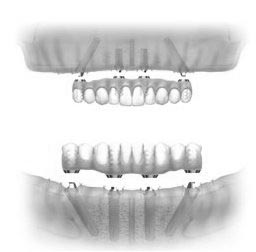Header logo
header top contact widget
Financing Options
Difference Between Crown-&-Bridge And Dental Implants
Posted on Sep 28, 2017 by William J. Claiborne, DDS MS
When replacing one, two or several teeth in one area, one option is a crown & bridge. For many individuals, it seems most practical to go with the less-expensive option. Yet, there are several reasons you should weigh the advantages of Dental Implants vs. crowns and bridges, which are far more important than ‘perceived’ costs.
A bridge, initially, costs less than Dental Implants. Although the cost of a crown-&-bridge combination seems like ‘the way to go’ when it comes to replacing a tooth or teeth, many people are unaware of the long-term expenses and underlying issues.
Yet, over time, a crown-&-bridge can require upkeep. From root canals to crown replacement to cracked bridges that need replacing, these costs add up, and up and up and…
Let’s look at the differences between Dental Implants and crown-&-bridge other than cost.
Dental Implants are held by the jaw bone, which provides the same foundation as that of natural tooth roots. This means that replacement teeth do not need the support of adjacent, natural teeth that have been crowned to serve to support a bridge. By keeping your natural teeth ‘natural,’ you are able to maintain the integrity of natural tooth structure, giving a strong advantage to your oral health.

An implant serves as a tooth root replacement, held by the jaw bone.
Because Dental Implants use the natural foundation of your jaw bone, they give another advantage to your oral health. Dental Implants integrate with the structure of your bone. They recreate the presence of natural tooth roots and halt the process of bone loss.
Bone loss from missing teeth, or ‘resorption,’ occurs from the lack of stimulation that tooth roots provide to the jaw bone. Through this, they help to prevent the bone loss and gum recession that often accompany bridgework and partials.
Bone loss is a concern since it can place neighboring teeth at risk. As the bone shrinks in the area of missing teeth, the foundation of those teeth is compromised. Odds are, when a tooth is lost, the next one you’ll lose is one adjacent due to this bone loss.
Yet another advantage of Dental Implants? – Their ability to look, feel and function just as natural teeth. Some people prefer to keep the fact that they wear Dental Implants a private issue. With Dental Implants, no one need to ever know you have a ‘third set’ of teeth. Non-removable implant systems allow you to wake up with a smile and brush your implanted teeth along with your natural teeth!
The success rate of Dental Implants is one of the highest implant-in-bone types, including hips and knees. Properly selected, placed and maintained, Dental Implants offer a lifetime solution for tooth replacement. As a Periodontal specialist, I provide specific expertise in the diagnosis and placement of Dental Implants. This gives our patients an edge — specific knowledge, training and skills so they can enjoy teeth that look and feel just like their own (because they are!).
Consider Dental Implants based on the long-term advantages, for optimal oral health as well as a wise investment that will last your lifetime. Call (828) 274-9440 for a consultation to discuss your needs.
Correcting A Gummy Smile With Beautiful Results!
Posted on Sep 06, 2017 by William J. Claiborne, DDS MS
A smile says a lot. A warm, genuine smile sends a message to others of acceptance and joy. A beautiful smile also complements appearance and can relay an impression of confidence, happiness and openness.
As a Periodontist, I treat the soft tissues of the mouth in addition to placing dental implants and treating gum disease. As an expert in oral gum tissues, I have advanced training that enables me to create gum tissue contours to give a natural appearance and provide healthy seals around teeth.
For people who have a ‘gummy smile,’ too much gum line is visible above the upper teeth in a full smile. While this trait does not interfere with the ability to have and maintain a healthy smile, for many, it causes them to ‘hold back’ rather than smile fully. Some people cover their smiles with a hand or try to smile with lips only.
For many with a gummy smile, the deterrents to having it repaired are (1) cost; (2) treatment discomfort; and (3) treatment time. However, in consultations with patients, I explain how modern techniques ensure exceptional comfort and reduce healing time. Often, once the patient is better informed as to what to expect, they are receptive to proceeding.
Gum re-contouring is the procedure to correct a gummy smile, referred to as a ‘gingivectomy.’ It is performed to remove the excess gum tissue that arches over the teeth most visible in a smile.
To begin, we numb the gum tissues and carefully trim the excess. As a Periodontist, I take specific measures to ensure a natural looking arch remains over the teeth while preserving the natural points that ‘dip’ between each tooth.
It’s normal to experience some tenderness or swelling after the procedure, however, most patients do fine by applying an ice pack off and on for the first day. In most cases, over-the-counter pain medications are sufficient, however, we make prescription strength options available to ensure comfort during the healing process.
Healing time depends on each individual and can vary from a few days to a few weeks. For patients who smoke, healing times are longer due to smoking’s drying effect on gum tissues.
Most gingivectomies are followed by crown lengthening procedures that enhance the appearance of the teeth most visible in a smile. Crown lengthening uses porcelain veneers or crowns to give a beautiful, even smile line.
Treatment fees depend on the extent of the condition and whether crowns or veneers will be applied following treatment. In either case, beautiful results can occur, helping the individual who once ‘held back’ to smile confidently and reveal a more outgoing, vibrant personality!
A healthy smile is a benefit to our overall health. An attractive, confident smile is beneficial to our self-image, helping us to feel good from the inside out! Call 828-274-9440 for a consultation to discuss a gingivectomy and what is recommended for your specific need.
Dental Implant Vs. Crown-&-Bridge
Posted on Jun 14, 2017 by William J. Claiborne, DDS MS
For those who have lost one or several teeth, adults have often gravitated to a crown and bridge combination. However, that option is becoming ‘second fiddle’ to the lifetime tooth replacement solution of Dental Implants.
Dental Implants are made from titanium, which is a material that biologically bonds with living bone. Implants that are properly selected, placed and maintained are designed to last a lifetime. An implant will never get a cavity, need a root canal, or create risk for surrounding natural teeth. Dental Implants are the closest thing to the look, feel and function of natural teeth.
When it comes to choosing a Dental Implant or a Crown-&-Bridge to replace a missing tooth or teeth, the only deterrent seems the price tag. However, when comparing the overall, longterm expense to the initial costs, implants stand out as a far better value.
First, an implant does not rely on neighboring teeth for support, as does a crown-&-bridge combination. A bridge must be attached to adjacent teeth on both sides for support. This is done by crowning otherwise healthy natural teeth that are attached to the bridge. Once a tooth is crowned (or ‘capped’), it will always need a crown. 
A Dental Implant does not rely on the support of adjacent teeth. It is anchored by the jaw bone, having the same, sturdy foundation as natural tooth roots once had. And, one implant can often support one, two or more teeth. Since the cost of implant treatment is largely based on the number of implants placed, this keeps treatment costs more manageable .
Another advantage of Dental Implants over Crown-&-Bridge is in the prevention of bone loss. When natural tooth roots are removed from the jaw bone, the bone begins to decline in mass. This process is known as resorption. This can be visible when the area of gum tissue under (or above) the bridge diminishes. Eventually, a smile can reveal a gap between the bridge and the gums.
As the bone declines, the teeth supporting the bridge are at greater risk. On average, the next teeth to be lost are teeth adjacent to areas of missing teeth. Because Dental Implants recreate the presence of tooth roots, they help to halt bone resorption. And, since implants are held by the jaw, they restore comfortable and stable biting and chewing.
We urge patients to look past the initial costs to replace teeth and assess the lasting advantages of Dental Implants. They are actually a much wiser investment, not to mention to many benefits they provide.
If you have considered replacing teeth with Dental Implants, call 828-254-9440 to schedule a consultation.
Different Implant Designs For Different Needs
Posted on May 22, 2017 by William J. Claiborne, DDS MS
As a dental specialist with advanced skills in the diagnosis and placement of Dental Implants, I enjoy staying on top of the latest techniques, technology and materials. Over the years, I have been especially excited to provide our patients with the advancements that make implant dentistry such an ideal option in tooth replacement.
Today’s implant dentistry is successful, safe, dependable and often immediate. As the doctor who places the implants, having a role in restoring a patient’s ability to bite, chew, speak and laugh has been a major highlight in a rewarding career.
One of the reasons for the high success rate of Dental Implants is in the design of different systems. For decades, Implant designs have been fine-tuned so various systems are able to accommodate specific challenges and preferences. In addition to being more affordable than ever, implant systems are now available for nearly every situation, including:
Implants Supporting Non-Removable Teeth – For some, removable teeth attached to implants were too similar to the denture they had (and detested). Even though these removable replacement teeth are firmly secured to the implants, most individuals want teeth that do not come out. However, some of the more affordable systems have been those that support removable teeth. Now, an implant system known as All-On
-4 is able to support non-removable teeth using just 4 strategically-placed implants. By positioning the implanted portions at unique angles, the biting and chewing forces are distributed evenly among fewer implants. Another advantage of this system is its ability to be placed in minimal bone. Long-time denture wearers are often challenged because of severe bone loss. Having insufficient bone mass to support Implants has prevented some people from having implants or required bone rebuilding procedures prior to implant placement. The All-On-4 implant system is able to overcome this obstacle.
Traditional Dental Implants – Still today, the ‘gold standard’ for most implant treatment requires several stages. Placement of the implants is performed first. For several months after, the bone goes through a process known as ‘osseo-integration.’ This takes place over a 3-6 month period and secures the implant in the upper or lower jaw bone, similar to natural tooth roots. Once secured, the implant sites are uncovered and a post is positioned inside to which the replacement teeth are secured. During osseointegration, however, patients are able to comfortably wear their denture or partial.
Fast-Track Dental Implants – As the design of implant systems have advanced with the involvement of computerized technology, implant placement and teeth attachment can often be completed in less time than that required by traditional implants. Having the ability to pre-select ideal placement positions prior means that, in some cases, immediate attachment of teeth can occur. While this option isn’t appropriate for everyone, certain patients are, indeed, excellent candidates. This is why it is important to have an experienced and highly-trained doctor coordinate your diagnosis and placement. When your individual needs are carefully assessed, a successful outcome has greater potential with the foundation of a proper diagnosis and implant selection.
Dental Implants are the closest thing to the natural teeth you once had. They are also designed to last a lifetime, making them an excellent investment. The type of implant system best suited to your needs will be discussed after an examination and review of Panorex (jaw-to-jaw) imaging.
Let’s discuss the implant system that is best for your needs and goals during a private consultation appointment. We’ll also discuss comfort options, including Oral and I.V. Sedation. Call 828-274-9440.
Recent Posts
Categories
Archives
- September 2024
- August 2024
- July 2024
- June 2024
- May 2024
- April 2024
- March 2024
- February 2024
- January 2024
- December 2023
- November 2023
- October 2023
- September 2023
- August 2023
- July 2023
- June 2023
- May 2023
- April 2023
- March 2023
- February 2023
- January 2023
- December 2022
- November 2022
- October 2022
- September 2022
- August 2022
- July 2022
- June 2022
- May 2022
- April 2022
- March 2022
- February 2022
- January 2022
- December 2021
- November 2021
- October 2021
- September 2021
- August 2021
- July 2021
- June 2021
- May 2021
- April 2021
- March 2021
- February 2021
- January 2021
- December 2020
- November 2020
- October 2020
- September 2020
- August 2020
- July 2020
- June 2020
- May 2020
- April 2020
- March 2020
- February 2020
- January 2020
- December 2019
- November 2019
- October 2019
- September 2019
- August 2019
- July 2019
- June 2019
- May 2019
- April 2019
- March 2019
- February 2019
- January 2019
- December 2018
- November 2018
- October 2018
- September 2018
- August 2018
- July 2018
- June 2018
- May 2018
- April 2018
- March 2018
- February 2018
- January 2018
- December 2017
- November 2017
- October 2017
- September 2017
- August 2017
- July 2017
- June 2017
- May 2017
- April 2017
- March 2017
- February 2017
- January 2017
- December 2016
- November 2016
- October 2016
- September 2016
- August 2016
- July 2016
- June 2016
- May 2016
- April 2016
- March 2016
- February 2016
- January 2016
- December 2015
- November 2015
- October 2015
- September 2015
- August 2015
- July 2015
- June 2015
- May 2015
- April 2015
- March 2015
- February 2015
- January 2015
- December 2014
- November 2014
- October 2014
- September 2014
- August 2014
- July 2014
- June 2014
- May 2014
- April 2014
- March 2014
- February 2014
- January 2014
- December 2013
- November 2013
- October 2013
- September 2013
- August 2013
- July 2013
- June 2013
- May 2013
- April 2013
- March 2013
- February 2013
- January 2013
- December 2012
- November 2012
- October 2012
- September 2012
- August 2012
- July 2012
- June 2012




